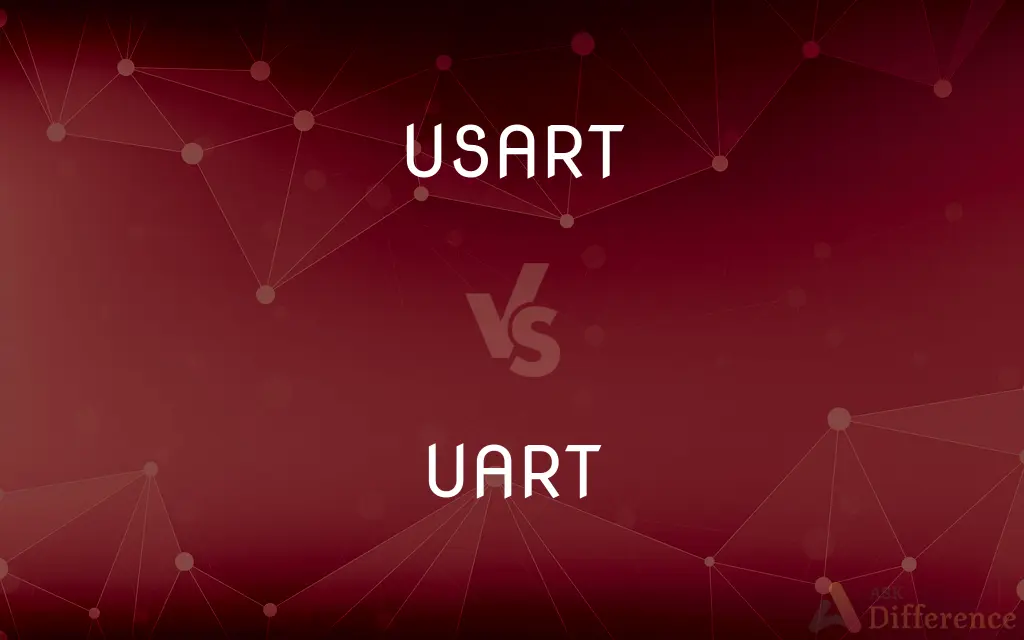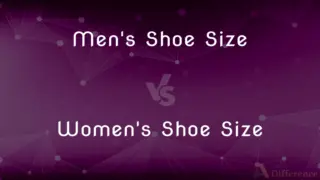USART vs. UART — What's the Difference?
By Tayyaba Rehman & Urooj Arif — Published on February 7, 2024
USART (Universal Synchronous/Asynchronous Receiver/Transmitter) supports both synchronous and asynchronous transmission, while UART (Universal Asynchronous Receiver/Transmitter) only supports asynchronous transmission.

Difference Between USART and UART
Table of Contents
ADVERTISEMENT
Key Differences
USART stands for Universal Synchronous/Asynchronous Receiver/Transmitter, indicating its ability to handle both synchronous and asynchronous data transmission. This flexibility allows it to be used in a wider range of communication scenarios. On the other hand, UART (Universal Asynchronous Receiver/Transmitter) is limited to asynchronous communication only, where data is sent without a shared clock signal.
In terms of data transmission efficiency, USART can be more efficient because synchronous transmission allows for higher data rates under certain conditions. This is due to the presence of a clock signal that synchronizes the transmitter and receiver. UART, while simpler in design and easier to implement, may not achieve the same data rates as USART in synchronous mode.
When considering the complexity of the hardware and implementation, USART is generally more complex due to its dual-mode functionality. This complexity can translate to higher costs and more intricate programming requirements. UART, in contrast, is simpler, making it a more cost-effective and straightforward solution for basic serial communication needs.
USART is often found in applications where the flexibility of choosing between synchronous and asynchronous communication is necessary. This might include high-speed data logging systems or communication with certain types of peripheral devices. UART is commonly used in applications where the simplicity of asynchronous transmission is sufficient, such as in basic serial communication between microcontrollers and computer systems.
From a technical perspective, the synchronization method in USART can lead to more efficient error detection and correction mechanisms, especially in noisy environments. UART, lacking this synchronization, relies on start and stop bits to frame the data, which can be less efficient in terms of bandwidth usage but simpler in terms of error handling.
ADVERTISEMENT
Comparison Chart
Communication Type
Supports both synchronous and asynchronous modes.
Only supports asynchronous mode.
Data Transmission Rate
Generally higher, especially in synchronous mode.
Lower compared to USART’s synchronous mode.
Complexity
More complex due to dual-mode functionality.
Simpler, focused on asynchronous communication.
Implementation Cost
Typically higher due to increased complexity.
Lower, due to simpler design and functionality.
Typical Applications
Used in versatile communication scenarios, including high-speed data transfer.
Common in basic serial communications and simpler devices.
Compare with Definitions
USART
USART stands for a communication interface that can adjust to either synchronized or unsynchronized transmission methods.
For the experimental drone, we chose USART to handle various communication scenarios with ground stations.
UART
UART is a communication device exclusively designed for asynchronous serial data transfer.
Our basic sensor network utilizes UART for simple and reliable data exchange.
USART
USART is an integrated circuit used for serial communication, capable of operating under varying clocking mechanisms.
USART's synchronous mode was crucial for achieving the high data rate needed in our telemetry application.
UART
UART is an integrated circuit used primarily for serial communication in an asynchronous manner.
Our prototype's diagnostic port features UART for easy and straightforward data logging.
USART
USART is a communication device supporting both synchronous and asynchronous serial data transfer.
The new networking module uses USART for efficient high-speed data communication.
UART
UART stands for a communication interface focusing on simplicity and ease of implementation for serial data exchange.
To reduce complexity, our remote sensors communicate with the base station using UART.
USART
USART enables data transmission with or without an external clock signal, offering flexibility in communication protocols.
In our robotic control system, USART facilitates synchronous communication with sensors.
UART
UART transmits data without the need for a shared clock signal, simplifying the communication process.
The microcontroller uses UART for sending sensor data without complex synchronization.
USART
USART is versatile in digital communication, adapting to different transmission modes as per requirement.
The satellite communication system employs USART for its ability to switch between synchronous and asynchronous modes.
UART
UART is fundamental in digital communication for devices where synchronization is not required.
In the handheld scanner, UART provides efficient asynchronous data transmission to the central system.
Common Curiosities
What does UART stand for?
UART stands for Universal Asynchronous Receiver/Transmitter.
Which is more complex, USART or UART?
USART is generally more complex due to its dual-mode (synchronous and asynchronous) functionality.
Are USART and UART interchangeable?
No, they serve different purposes; USART is more versatile, while UART is simpler and specific to asynchronous communication.
Does USART offer higher data transmission rates than UART?
Yes, USART can offer higher data rates, especially in its synchronous mode.
Can USART handle both synchronous and asynchronous communication?
Yes, USART can handle both synchronous and asynchronous communication modes.
What does USART stand for?
USART stands for Universal Synchronous/Asynchronous Receiver/Transmitter.
Can UART handle synchronous communication?
No, UART is designed solely for asynchronous communication.
Do both USART and UART require external clock signals?
USART can operate with or without an external clock, while UART does not use an external clock.
Are there specific applications where USART is preferred over UART?
Yes, in applications requiring high-speed or flexible communication modes, USART is preferred.
Is UART limited to asynchronous communication?
Yes, UART is specifically designed for asynchronous communication only.
Is UART easier to implement than USART?
Yes, UART is simpler and easier to implement compared to USART.
Can USART be used in place of UART?
Technically, yes, as USART includes asynchronous capabilities, but it might be an overkill for simple applications.
Which is more cost-effective, USART or UART?
UART is generally more cost-effective due to its simpler design.
Is UART suitable for high-speed data transfer?
UART can be used for high-speed data transfer but is typically slower than USART's synchronous mode.
Is programming complexity higher in USART compared to UART?
Yes, due to its dual-mode capability, programming USART can be more complex than programming UART.
Share Your Discovery

Previous Comparison
Bruce Lee vs. Chuck Norris
Next Comparison
Men’s Shoe Size vs. Women’s Shoe SizeAuthor Spotlight
Written by
Tayyaba RehmanTayyaba Rehman is a distinguished writer, currently serving as a primary contributor to askdifference.com. As a researcher in semantics and etymology, Tayyaba's passion for the complexity of languages and their distinctions has found a perfect home on the platform. Tayyaba delves into the intricacies of language, distinguishing between commonly confused words and phrases, thereby providing clarity for readers worldwide.
Co-written by
Urooj ArifUrooj is a skilled content writer at Ask Difference, known for her exceptional ability to simplify complex topics into engaging and informative content. With a passion for research and a flair for clear, concise writing, she consistently delivers articles that resonate with our diverse audience.













































